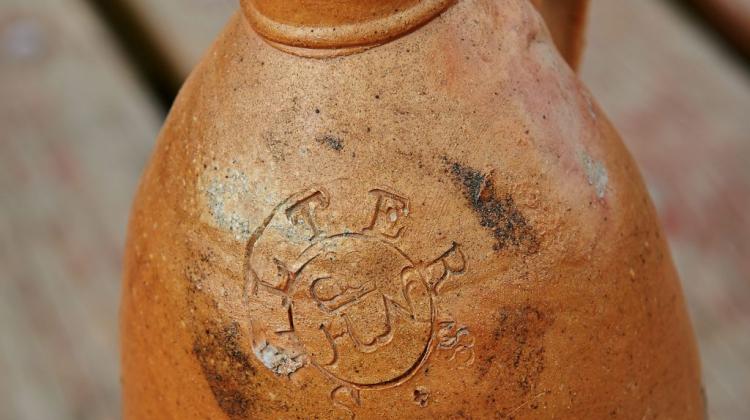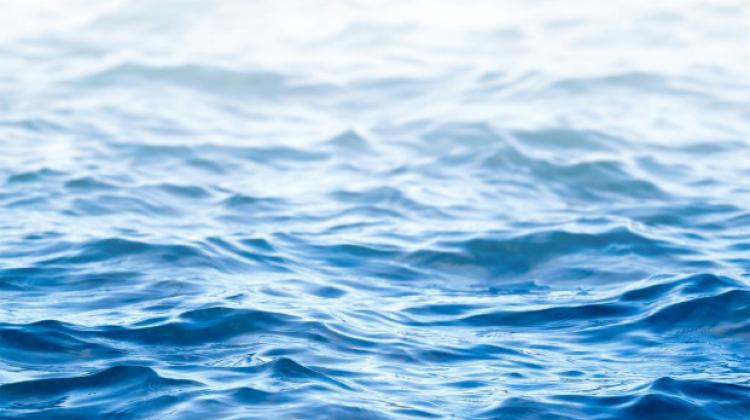Research confirms gin in 200-year-old bottle recovered from the Baltic

After additional tests experts are almost certain that the stoneware bottle recovered from the wreckage of a sailing ship, which sank in the Gulf of Gdansk approx. 200 years ago, originally contained genever gin - traditional liquor of the Netherlands and Belgium.
The bottle was recovered from the wreck, which rests on the bottom of the Gulf, at a depth of 12 meters, approx 4 km east of Gdynia Orłowo. The remains of the ship were discovered last year, during a routine survey of the bottom, by the staff of the Maritime Office in Gdynia. They notified the archaeologists from the National Maritime Museum, who in June and July conducted a survey of the wreck with the help of divers.
Archaeologists recovered parts of the ship, including wooden blocks, as well as fragments and whole specimens of vessels, including a 30 cm high stoneware bottle containing a liquid. The vessel was perfectly preserved and corked, and embossed writing "Selters" suggested that it might contain soda water produced for several centuries near the village of the same name in the Taunus mountain range in Germany.
In early July, archaeologists transferred the bottle to research laboratory J.S. Hamilton Poland in Gdynia. After a few weeks, experts issued a preliminary opinion, according to which the bottle contained 14-percent alcohol distillate. In they view, the vessel could initially contain a stronger beverage, which was diluted with water. They already suspected that the bottle could contain diluted genever gin - traditional liquor of the Netherlands and Belgium. However, they decided to carry out additional, more detailed tests.
Last Monday, experts who studied the fluid, delivered the final results to the museum. "On the basis of tests and calculations, we found that the bottle originally contained 43-percent alcohol, which was diluted with sea water from the Gulf of Gdańsk. Apparently the cork, which sealed the neck of the vessel, was not quite tight and when the ship sank, water from the Baltic Sea spilled into the bottle" - told PAP laboratory expert Dr. Stanisław Kmieciak.
The expert added that the extraordinary purity of alcohol indicated that it could not be a vodka or whiskey. "These two spirits are distilled only once, so the liquid would contain more impurities. In contrast, genever is distilled twice, so alcohol is purer" - Kmieciak told PAP and added that the liquid also contained trace amounts of compounds found in juniper berries.
"All this allows to conclude with very high probability that the bottle originally contained genever gin that apparently someone poured into a bottle of mineral water. Anyway, genever, often used for medicinal purposes, had been traditionally sold and stored in stoneware bottles" - concluded Kmieciak.
Stoneware bottle with the writing "Selters" was not the first vessel with contents recovered from the seabed by underwater archaeologists from the National Maritime Museum. In 2009, during the exploration of another wreck, the researchers found two, also approx. 200-year-old surprises: a large stoneware jar that contained butter and a bottle of beer. Of course, the products were not preserved.
After a preliminary examination of the wreck, from which stoneware bottle was recovered, archaeologists concluded that the vessel could be built in the early nineteenth century. Tomasz Bednarz, archaeologist from the National Maritime Museum told PAP that these suspicions were confirmed by tree-ring dating (allowing to determine when the tree was felled based on the grain of the wood).
According to Bednarz, research shows that the ship was built in the early 1830s, with wood from forests growing in Pomerania. He added that the ship was used to transport goods locally in the waters of the Gulf of Gdańsk. The specific design of the ship and a large number of stones found in the wreckage suggest that it was used to carry this building material. Archaeologists called the wreck "Głazik" (little rock). "The stones it carried when it sunk were probably intended to be used for the construction of fortifications at the entrance to the Port of Gdańsk" - the archaeologist told PAP.
PAP - Nauka w Polsce
aks/ ls/ mrt/
tr. RL
Przed dodaniem komentarza prosimy o zapoznanie z Regulaminem forum serwisu Nauka w Polsce.


















